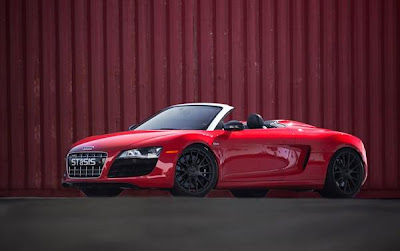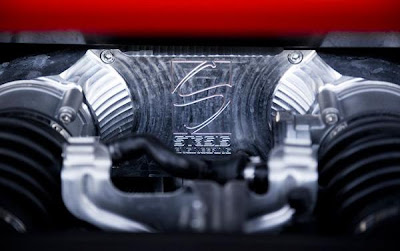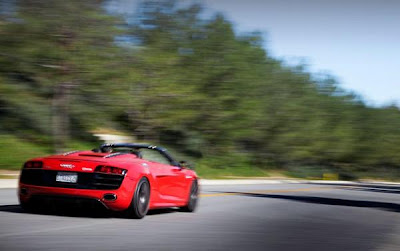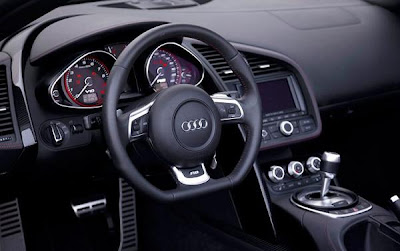Audi R8 Spyder






It’s hard to improve on greatness, so when Stasis Engineering offered us a short drive of its modified Audi R8 Spyder, we were excited and skittish. The last time we debarked from a stock Audi R8 5.2 FSI, we concluded that Audi had improved upon near-perfection. Could Stasis improve the R8 even further, or would its upgrades actually set the car back? We intend to find out.
So now I’m sitting in Stasis’ impeccable show car with Henry Hsu, the company’s director of engineering. When traffic clears, Hsu unhesitatingly double-slaps the R Tronic’s left paddle until a bright “2″ appears on the dash. Revs erupt as the twin oval pipes’ bark turns into a menacing roar. Eaton’s biggest automotive supercharger whines and churns at a maximum 7.5 PSI. Everything blurs. My eyes water. WHOA.
“Your turn,” the engineer says, grinning widely as he checks the car’s digitized vitals.
With 710 supercharged horsepower on tap, this 5.2 FSI Spyder is Stasis’ most powerful 50-state-legal creation, topping the brand’s two factory dealer-installed upgrades. (A milder 552-horsepower Touring Edition is the other.) Tacking on the aptly titled Challenge Extreme Edition badge gives a roots-type TVS 2300 blower with bespoke cooling system, ECU tuning, and a less restrictive, hand-welded 3-inch T-305 stainless steel exhaust. Our tester also sports revised suspension, forged aluminum wheels, Michelin Pilot Sport PS2 tires, and Alcon brakes with braided stainless steel lines and stickier pads.
At a crawl, the blown 5.2-liter V-10 corrals a herd of pent-up thrust — 523 pound-feet of torque support the buffed-out equines, much of them available below 5500 rpm. The TIG-welded exhaust grumbles and pops, but doesn’t have an ear-piercing drone. If a Dodge Viper SRT-10 and Lamborghini Murcielago LP670-4 Super Veloce ever made mechanical love, the result would sound like this. With 185 horsepower and 132 pound-feet over Neckarsulm’s base, this Spyder packs a very poisonous bite.
A bright yellow “Curves Next 2 Miles” sign appears once we’re outside suburbia. As if preparing for a Homeric battle, I nudge the left paddle three times to engage second gear, sit up, and align my sights.
Not surprisingly, turning into a corner remains a beautifully engineered, fluid, and responsive act bearing loads of grip the perennial R8 way. Now with wider 265/30-20 PS2 rubber (on 20 x 9.5-inch alloys), front end bite is near magnetic. At mid-corner, the gigantic 20 x 12-inch forged rear wheels (wrapped in astounding 325/25-20 tires) secure the R8′s footing even further than stock limits, allowing for all 710 sets of hooves to pummel the tarmac. The R8 adheres to every road nuance as though preprogrammed, and with such copious supercharged power available at a mere 2000 rpm, it devours them.
Much of this prowess comes from the upgraded suspension, which rides 1 inch lower via higher rate springs. Hsu’s team didn’t alter the electromagnetic suspension’s Drive Select settings, so users can still change from Normal to Sport while on the fly (customers desiring the highest level of adjustability can opt for the full Öhlins coilovers).
New anti-roll bars replace Audi’s renditions to improve overall rigidity, and with everything set, there is no jouncing, knocking, or tire-rubbing — only a slightly stiffer ride, better grip, and one badass look.
We come to a short straightaway. With my right foot to the floor, a hefty dose of raw shove rockets us into triple-digit speeds in a few hundred feet. Hsu reckons the R8 can hit 60 mph from a standstill in 3.1 seconds. Install this package on the lighter R8 V-10 Coupe (which takes 3.4 seconds to get to 60 mph in stock form) and there’s potential for even greater performance. Just as my vision tunnels, the bigger two-piece Alcons (15.35-inch front, 14.0-inch rear) halt our forward progress. And so the story goes for the next couple miles.
Though built by Stasis HQ in West Virginia, the Challenge Extreme doles its power as smoothly, collectedly, and reliably as anything created by quattro. Every horse and associated pound-foot gradually flexes, growing more forceful as subsequent shifts and additional throttle are summoned. (If you’re wondering why Hsu and Co. didn’t turn up the Eaton’s PSI, it’s for reliability and street worthiness. Every car built by Stasis is covered by a four year/50,000 mile warranty that runs concurrently with the factory warranty — think Dinan and BMW). If it weren’t for the blower’s delicious whine, the Stasis R8 could be mistaken for naturally aspirated. It’s that smooth and well orchestrated.
The R8 has one major flaw, and it isn’t a result of Stasis’ touch. As we’ve noted in stock variants, the R Tronic’s mid-shift delay produces a vehicle lurch that soon becomes annoying during spirited runs. Although stout enough to handle loads of power and hours of abuse, the single-clutch unit shifts considerably slower than today’s top dual-clutch systems.
Nonetheless, after the short drive it is clear that Stasis quality is second to none in the aftermarket game. We’ve driven many an Audi R8 in recent years — including highly modified versions like the 620-horsepower ABT-Sportline R8 GTR, $430,000 PPI Razor GTR10, and Audi’s own limited edition weekend racer, the 2012 R8 GT– but no other R8 has given us a ride like the Challenge Extreme Edition.
At around $221,000 (about $172,000 for the R8 plus $49,000 in upgrades, or $39,000 for the engine package alone), the Stasis R8 is no small buy. But considering it can easily be labeled the ultimate R8, it is worth every penny.















